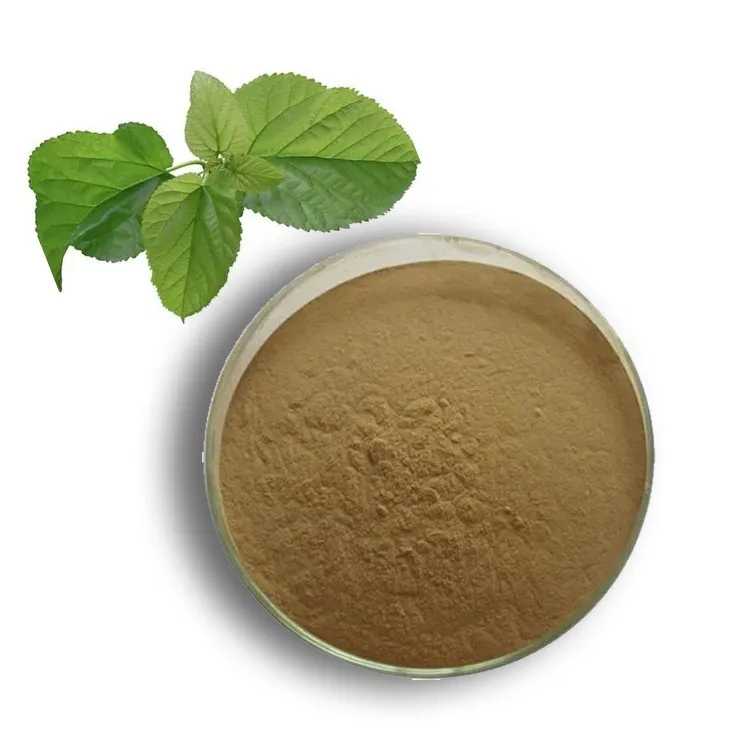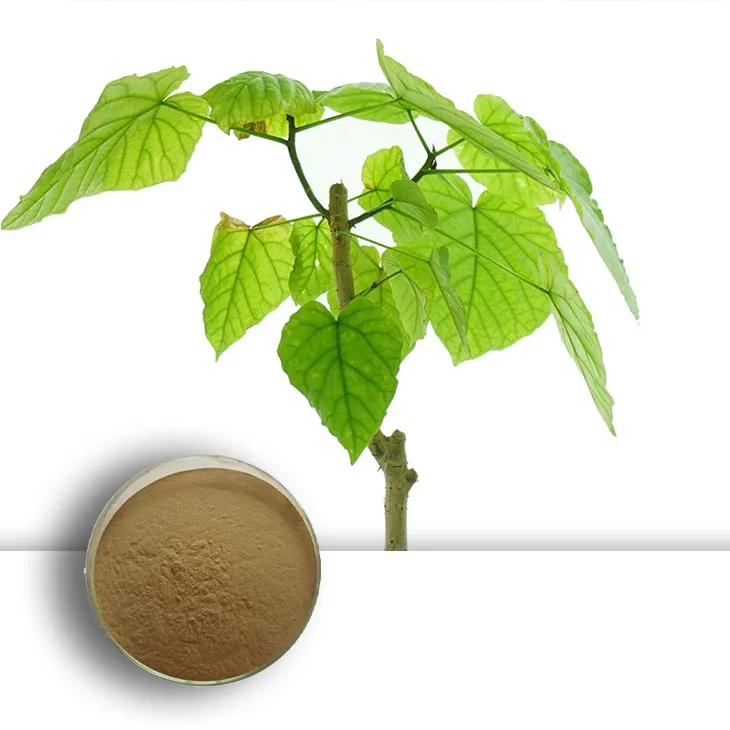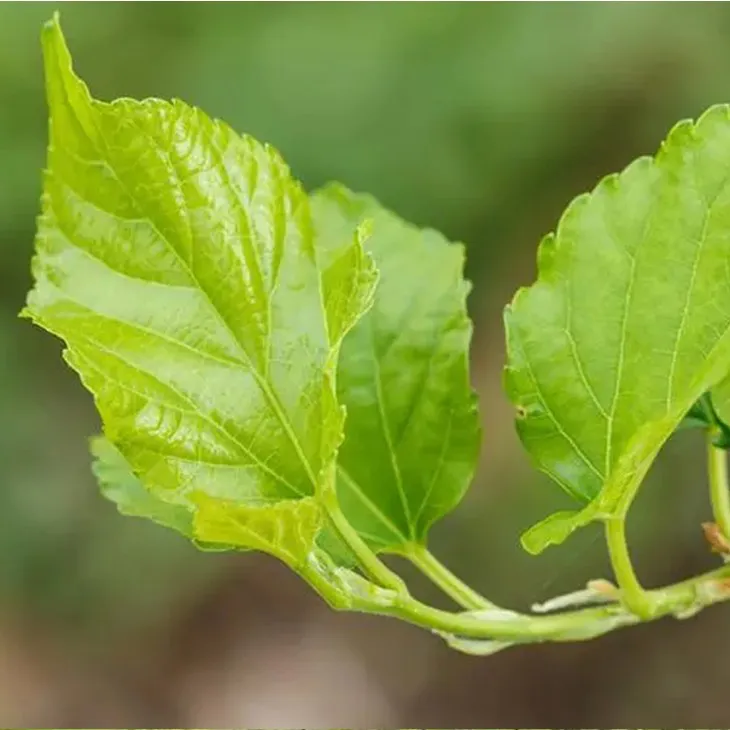- 0086-571-85302990
- sales@greenskybio.com
The extraction process of mulberry leaf extract.
2024-11-29

1. Introduction
Mulberry leaves have been recognized for their potential health benefits and diverse applications in various fields, especially in traditional medicine and the development of health - promoting products. The extraction of Mulberry leaf Extract is a crucial process to obtain the valuable substances contained within the leaves. This article will provide a comprehensive overview of the extraction process, including the collection of raw materials, extraction techniques, purification methods, and the significance of the final extract.

2. Collection of Mulberry Leaves
2.1. Selection of Mulberry Varieties There are different varieties of mulberry trees, and the choice of variety significantly impacts the quality of the leaves and the subsequent extract. Some varieties are known for their higher content of active compounds. For example, the Morus alba variety is commonly used due to its wide availability and relatively rich content of bioactive substances such as flavonoids and alkaloids.
2.2. Harvesting Time The harvesting time of mulberry leaves is crucial. Generally, leaves are harvested during the growth period when the content of active ingredients is relatively high. For flavonoids, the optimal harvesting time may be in the middle to late growth stage of the leaves. Harvesting too early may result in insufficient accumulation of active substances, while harvesting too late may lead to a decrease in quality due to factors such as leaf senescence.
2.3. Quality Inspection After harvesting, the leaves need to undergo a strict quality inspection. This includes checking for the presence of pests, diseases, and physical damage. Only fresh, healthy, and high - quality leaves should be used for extraction. Any leaves with signs of mold or significant pest damage should be discarded to ensure the purity and quality of the final extract.

3. Extraction Techniques
3.1. Solvent Extraction
- Solvent extraction is one of the most commonly used methods. Different solvents can be selected based on the solubility of the target compounds in mulberry leaves. Commonly used solvents include ethanol, methanol, and water. Ethanol - water mixtures are often preferred as they can extract a wide range of compounds while also being relatively safe and easy to handle.
- The process involves soaking the mulberry leaves in the solvent for a certain period. The ratio of leaves to solvent, temperature, and extraction time all play important roles in determining the extraction efficiency. For example, a higher temperature may increase the solubility of the compounds, but it may also cause the degradation of some heat - sensitive substances.
3.2. Ultrasonic - Assisted Extraction
- Ultrasonic - assisted extraction has gained popularity in recent years due to its ability to enhance extraction efficiency. Ultrasonic waves create cavitation bubbles in the solvent, which collapse and generate high - pressure and high - temperature micro - environments. These micro - environments can break the cell walls of mulberry leaves more effectively, allowing the release of intracellular compounds.
- When using ultrasonic - assisted extraction, parameters such as ultrasonic power, frequency, and extraction time need to be optimized. For example, a higher ultrasonic power may lead to more intense cavitation effects, but it may also cause excessive damage to the active compounds if not properly controlled.
3.3. Supercritical Fluid Extraction
- Supercritical fluid extraction is a relatively advanced technique. Supercritical carbon dioxide (sc - CO₂) is often used as the extraction fluid. The advantage of using sc - CO₂ is that it has the properties of both gas and liquid, with high diffusivity and low viscosity. It can penetrate the pores of mulberry leaves easily and selectively extract target compounds.
- However, supercritical fluid extraction requires relatively complex equipment and precise control of parameters such as pressure and temperature. The cost of this method is relatively high, but it can obtain extracts with high purity and without solvent residues, which is very important for some applications in the food and pharmaceutical industries.

4. Purification Steps
4.1. Filtration
- After the extraction process, the extract contains a mixture of target compounds and impurities such as cell debris, undissolved solids, and solvent impurities. Filtration is the first step in purification. There are different types of filtration methods, such as vacuum filtration and membrane filtration.
- Vacuum filtration can quickly remove large - particle impurities by using a vacuum pump to create a pressure difference. Membrane filtration, on the other hand, can further purify the extract by selectively allowing molecules of a certain size to pass through. For example, ultra - filtration membranes can retain larger molecules while allowing smaller molecules of the target compounds to pass through.
4.2. Chromatographic Separation
- Chromatographic separation is a more precise purification method. There are various chromatographic techniques available, such as column chromatography, high - performance liquid chromatography (HPLC), and gas chromatography (GC). Column chromatography is often used in the initial purification stage. It uses a stationary phase (such as silica gel) and a mobile phase (such as an organic solvent) to separate different compounds based on their different affinities for the stationary and mobile phases.
- HPLC is a more advanced chromatographic technique with high separation efficiency and sensitivity. It can accurately separate and purify different components in the Mulberry leaf Extract, especially for the separation of flavonoids and alkaloids. GC is mainly used for the analysis and purification of volatile components in the extract.
4.3. Crystallization
- Crystallization is a method used to obtain pure compounds from the purified extract. For some target compounds in Mulberry leaf Extract, such as certain alkaloids, they can be crystallized by adjusting the solvent composition, temperature, and concentration.
- During the crystallization process, the solution is slowly cooled or evaporated to allow the target compound to form crystals. The crystals can then be separated from the mother liquor by filtration or centrifugation, obtaining a relatively pure compound.
5. Significance of Mulberry Leaf Extract
5.1. Applications in Traditional Medicine
- In traditional medicine, mulberry leaf extract has been used for centuries. It is believed to have properties such as reducing heat, relieving coughs, and promoting blood circulation. The bioactive compounds in the extract, such as flavonoids and alkaloids, are thought to be responsible for these medicinal effects. For example, some flavonoids have antioxidant and anti - inflammatory properties, which can help in the treatment of various inflammatory diseases.
- Mulberry leaf extract is also used in traditional Chinese medicine formulas. It is often combined with other herbs to enhance the overall therapeutic effect. For example, in some prescriptions for treating diabetes, mulberry leaf extract may be combined with herbs that can regulate blood sugar levels to achieve better control of blood glucose.
5.2. Health - Promoting Products
- In the field of health - promoting products, mulberry leaf extract is widely used. It can be added to dietary supplements, such as capsules and tablets, to provide consumers with the potential health benefits of the extract. The antioxidant properties of the extract can help in preventing oxidative damage in the body, which is associated with aging and various chronic diseases.
- Mulberry leaf extract can also be incorporated into functional foods, such as beverages and snacks. For example, some tea products containing mulberry leaf extract are popular for their potential health - promoting effects, such as helping with weight loss and improving digestion.
5.3. Cosmetic Applications
- In the cosmetic industry, mulberry leaf extract has also found its applications. The antioxidant and anti - inflammatory properties of the extract make it suitable for use in skin - care products. It can be added to creams, lotions, and serums to help protect the skin from environmental damage, reduce inflammation, and improve skin complexion.
- Some studies have also shown that certain compounds in mulberry leaf extract may have anti - aging effects on the skin, such as promoting collagen synthesis and reducing the appearance of wrinkles.
6. Conclusion
The extraction process of mulberry leaf extract is a complex but important process. From the collection of high - quality mulberry leaves to the selection of appropriate extraction techniques and purification steps, each stage plays a crucial role in obtaining a high - quality extract. The significance of mulberry leaf extract in traditional medicine, health - promoting products, and cosmetic applications further emphasizes the importance of this extraction process. With the continuous development of technology, more efficient and environmentally friendly extraction and purification methods are expected to be developed in the future, which will further promote the utilization of mulberry leaf extract in various fields.
FAQ:
What are the main steps in the extraction process of mulberry leaf extract?
The main steps include collecting fresh and high - quality mulberry leaves at first. Then, using extraction techniques like ultrasonic - assisted extraction. After that, purification steps are carried out to ensure the purity of the extract.
Why is ultrasonic - assisted extraction used in the extraction of mulberry leaf extract?
Ultrasonic - assisted extraction is used because it can enhance the extraction efficiency, which helps to obtain more of the desired substances from the mulberry leaves more effectively.
What is the significance of the purification step in the extraction of mulberry leaf extract?
The purification step is significant as it ensures the purity of the extract. A pure extract is crucial for various applications, such as in health - promoting products and traditional medicine research, as impurities may interfere with the effectiveness or safety of the final product.
What are the potential applications of mulberry leaf extract?
The potential applications of mulberry leaf extract are mainly in health - promoting products and traditional medicine research. For example, it may have properties beneficial for health that can be utilized in dietary supplements or in the study of traditional medicine remedies.
How to ensure the quality of the collected mulberry leaves for extraction?
To ensure the quality of the collected mulberry leaves, they should be fresh. They should be free from diseases, pests, and excessive chemical residues. Also, proper collection methods should be used to avoid damage to the leaves during the collection process.
Related literature
- Extraction and Characterization of Bioactive Compounds from Mulberry Leaves"
- "Optimization of Mulberry Leaf Extract Production: A Review"
- "The Role of Mulberry Leaf Extract in Health and Wellness"
- ▶ Hesperidin
- ▶ citrus bioflavonoids
- ▶ plant extract
- ▶ lycopene
- ▶ Diosmin
- ▶ Grape seed extract
- ▶ Sea buckthorn Juice Powder
- ▶ Beetroot powder
- ▶ Hops Extract
- ▶ Artichoke Extract
- ▶ Reishi mushroom extract
- ▶ Astaxanthin
- ▶ Green Tea Extract
- ▶ Curcumin Extract
- ▶ Horse Chestnut Extract
- ▶ Other Problems
- ▶ Boswellia Serrata Extract
- ▶ Resveratrol Extract
- ▶ Marigold Extract
- ▶ Grape Leaf Extract
- ▶ blog3
- ▶ blog4
-
The best peony root extract in nature.
2024-11-29
-
100% Pure Organic Baicalin.
2024-11-29
-
Organic Cordyceps Extract Powder Suppliers.
2024-11-29
-
Chinese cactus extract suppliers.
2024-11-29
-
Peppermint Extract Powder
2024-11-29
-
Quercetin
2024-11-29
-
Grape Leaf Extract
2024-11-29
-
Camu Camu Extract
2024-11-29
-
Clove Powder
2024-11-29
-
Cocoa Extract
2024-11-29
-
Resveratrol extract
2024-11-29
-
Bayberry Extract
2024-11-29
-
Black Garlic Extract
2024-11-29
-
Hawthorn Extract
2024-11-29





















